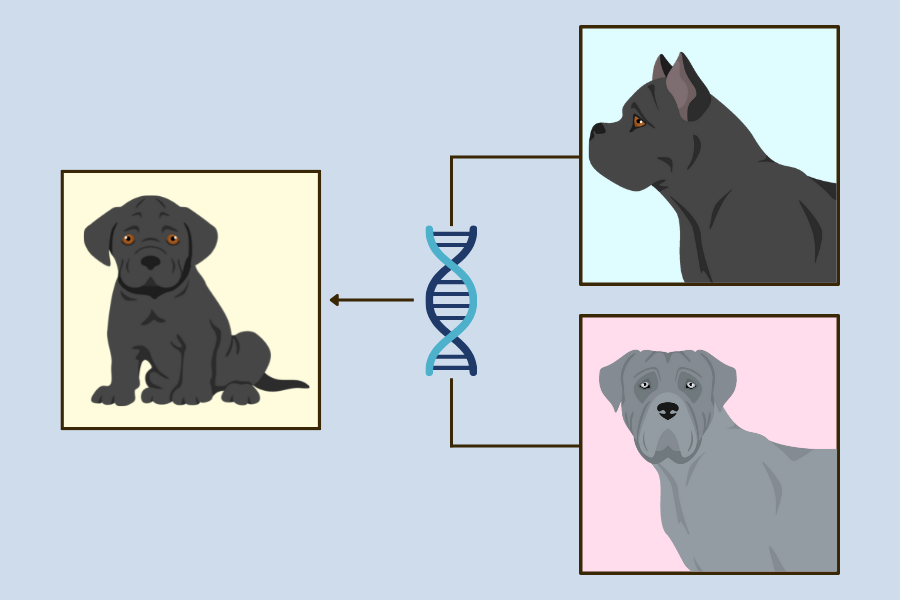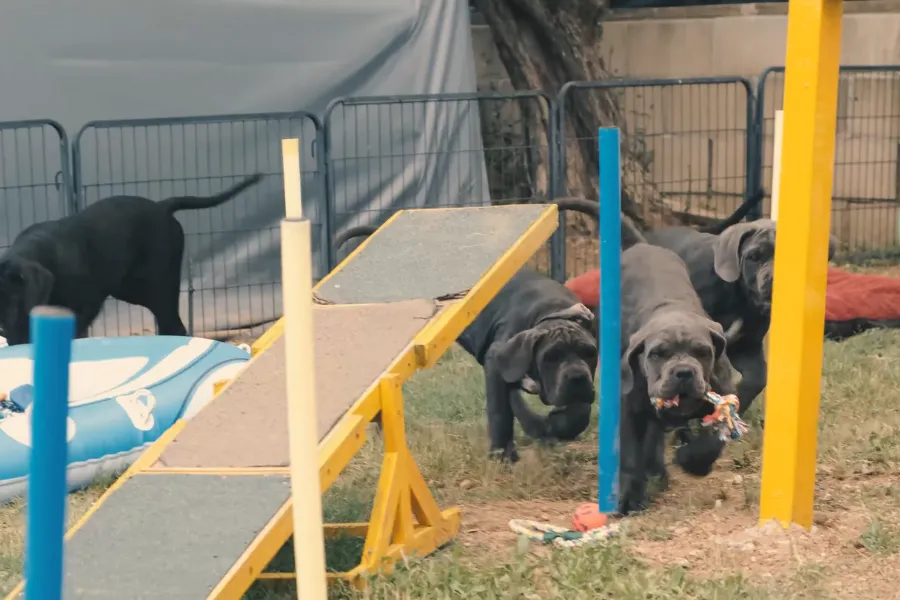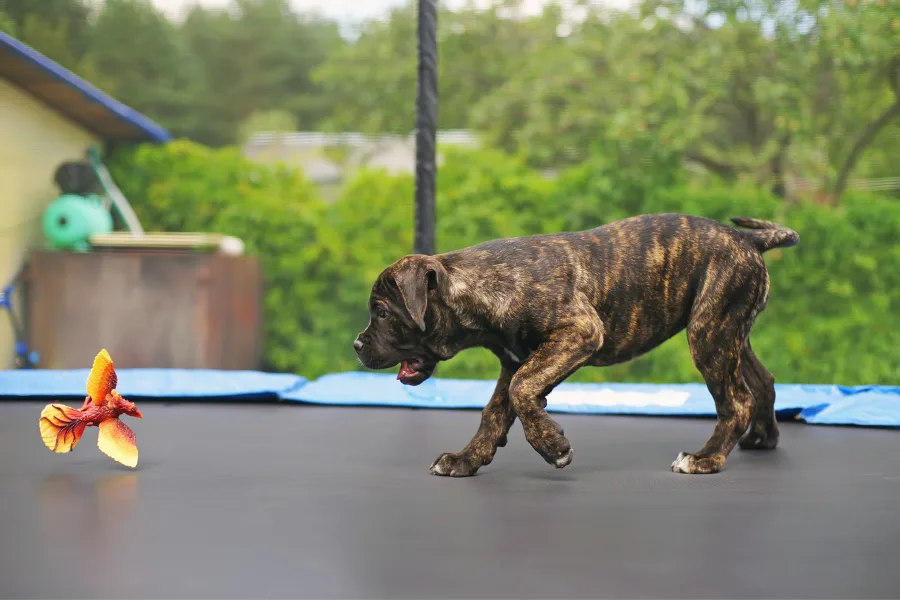Whether you are a breeder, a dog show enthusiast, or just regular folk looking for a companion dog and a new member of your family, you need to know how to choose a Cane Corso puppy from a litter of similar-looking (and behaving) puppies.
How to Choose the Best Cane Corso Puppy from a Litter? The only solid method of choosing a Cane Corso puppy from a litter is to do litter research, visual inspections, perform a series of health checks and temperament tests, and most importantly visit the kennel multiple times to spend time with each puppy.
6 Steps to Choosing the Perfect Cane Corso
- Perform Basic Litter Research
- Inspect the Environment of the Litter
- Ask The Breeder for the Best Puppy
- Spend Time With Each Puppy
- Basic Health Check
- Temperament Test
Hopefully, you were able to find a reputable Cane Corso breeder, and now you are ready to choose a puppy from their latest litter. Even in a great litter from exceptional parents, the puppies can have very different personalities. Some will be a great fit for you, and some won’t. Here’s how you can find the perfect puppy to bring home to your family.
Step 1: Perform Basic Litter Research
When the breeder you decided on confirms that the litter is on the way, the first step is to perform basic research on the mother and father of the puppies. This will give you an insight into the temperament, longevity, accomplishments, and health of the bloodline of your future puppy.
Ask your breeder for the parent’s pedigrees. If the breeder is hesitant and is trying to dodge your request, it’s certainly a red flag. A reputable breeder will always be happy to send you bloodline information about the dogs in the litter. It’s good practice to ask for a family tree that includes the registered names and the AKC registration numbers.
But what exactly does a pedigree mean to us as new owners? It shows whether the puppy we are getting originates from a lineage recognized by the FCI or the AKC. In this case, we will later be able to register our dog in the AKC register and compete in dog shows. And nothing else. All the beautiful names, titles, and accomplishments listed in the pedigree mean practically nothing to us in most cases. When it comes to inheritance traits nothing can be deduced from one pedigree. We would need to have extensive knowledge of the lineage of both parents, and only exceptionally skilled breeders go that far.
Research the lineage on Cane Corso Pedigree. Use the information and registration numbers the breeder gave you to do your own research on the lineage of the litter. The website has a huge database with over 10 thousand pedigrees and goes as far as 10 generations back. It is possible to calculate the coefficients of Kinship, Relationship, and Inbreeding of any Cane Corso very accurately. Using these tools has shown this pedigree database to be an extremely valuable resource of information used by breeders and enthusiasts.
While the Cane Corso Pedigree database is big, not every Cane Corso is listed there, so it shouldn’t necessarily raise a red flag.

Step 2: Inspect the Environment of the Litter
Since the first three weeks after the puppies’ birth the mother takes care of them herself, the kennels won’t differ much at that time. To find out how the breeder is raising the puppies and in what kind of environment they are living in, it is best to visit the kennel from the fourth week onwards.
It is important to get to know the breeder and visit the kennel where he is raising the puppies. When visually inspecting the kennel don’t be impressed by the technical equipment, flashy gadgets, and overly decorated yard with marble tiles and whatnot.
The only thing that matters is whether the puppies have plenty of contact and socialization with their environment. An improvised kennel in the backyard with a grass and gravel lawn will always be more charming and likable. Especially if there are items such as balls, ropes, rags, toys, and pieces of wood all over the yard.
If the puppies seem to live in horrible, unhealthy conditions and you sense that the breeder isn’t dealing with the puppies all that much, you should rethink getting the puppy from that breeder.
Look out for these red flags and health problems in the litter:
- The puppies react timidly to auditory and visual events.
- The puppies are overly shy or frightened by foreign people.
- The puppies are constantly attacking each other.
- Coughing, wheezing or sneezing.
- Lethargic and unresponsive.
- Signs of physical injuries.
- Any deformities.
- Any irregularity in how they walk.
If the puppies are curious, happy, and playful, it’s a sign that the breeder and his family are extensively socializing the puppies and are giving them proper attention. Overly shy or even fearful behavior in your presence is an immediate red flag.
It goes without saying that any signs of health issues are a concern, and shouldn’t be overlooked. The litter needs to be clean, hygienic, and safe. At first, the litter should be inside the house, but as they grow, the puppies need to spend more and more time outside (if the weather allows it) for playtime and to familiarize themselves with all sorts of different things and environments.

Step 3: Ask The Breeder for the Best Puppy
A responsible breeder will evaluate you every bit as much as you evaluate him and his litter to make sure he is selling his puppy to a good family. So, if you got to know your breeder and have gained each other’s trust, you should openly ask for their input and opinion on which puppy would be the best choice for you and your lifestyle.
The breeder is with his litter 24/7, and he knows his puppies’ individual traits and personalities very well. They will recommend a different puppy depending on your lifestyle.
- If you are a busy person with little free time for training and exercise, the breeder won’t pair you with a hyperactive puppy that will need at least 5 or 6 hours of intense work to tire itself out.
- On the other hand, if you are a hiker, jogger, or an overall sports person, they won’t pair you with a lazy puppy who likes to sloth around.
You should note to the breeder if you are looking for a “show standard” puppy, a puppy that u will later use for breeding, or a companion puppy. In any case, you should look if the puppy falls into the breed standard because there can be health issues if they are not up to the standard.
💡 Tip: The size of the puppy's paws can be a good indicator of how big it will get. The bigger the paws, the larger the dog will be.
Step 4: Spend Time With Each Puppy
Spending time with each puppy separately and without any distractions will allow you a closer look into the puppy’s temperament and health. Ask the breeder if he can provide you access to an area separated from the rest of the litter where you can interact with each puppy one-on-one.
An experienced breeder will appreciate the dedication and effort you put into finding the best puppy for you. They’ll understand your desire and will be more than willing to help and respond to any requests you have. At the end of the day, the breeder wants you to leave their kennel with a positive experience, as it will only help their business grow.
10 to 15 minutes of one-on-one time should be enough to check the puppy for any health issues and run a simplified temperament test. Obviously, you don’t need to spend time with all 6 to 10 puppies in the litter. You will probably eyeball 3 or 4 puppies that stand out from the rest.
What to do and what to look out for when interacting with the puppies:
Keep in mind that the puppies won’t always be in the same mood. For example, a little bloating can make an otherwise energetic puppy seem sluggish that day. Therefore, it is recommended to visit the litter several times.
- Your future four-legged companion shouldn’t react timidly to vocal and visual events.
- The puppy mustn’t constantly attack his brothers and sisters. It’s okay if he starts a fight with his siblings from time to time, but it shouldn’t be the rudest and most dominant puppy in the litter.
- Separate the puppy from the litter in an area with no distractions. There you will play with him and observe how he reacts and responds to you, your voice, and to toys with which you are trying to get his attention.
- Perform a basic health check (full health check here).
- Perform a temperament test (full temperament test here).
- Furthermore, you must be sure that you really like this puppy, that it is healthy and lively and that the breeder unconditionally recommends it to you.
Also, as you look at the dogs, don’t forget to look at these parts of the body to be certain that the puppy falls into the breed standard:
- The Overall Appearance: Look for big bones, a rectangular body, and developed muscles.
- Head: Look for a sculptured head with good angulation, jaw, nose, and proportions.
- Neck & Shoulders & Chest: Should be strong, firm, and well-defined.
- Top Line: Shouldn’t slope up or down.
- Forequarters & Hindquarters: Legs and paws pointing straight, mustn’t point inwards or outwards. Legs should be powerful and thick.
- Eyes: Make sure that the eye color meets the eye color standard.
- Movement: Make sure the puppy is walking straight and without difficulty. Look at all the body parts above while the puppy walks, to get a better idea of how all of them fit together.
This is just a short summary, you can take a deeper dive into the AKC’s Cane Corso Breed Standard.
If the breeder presented us with the pedigrees and certification that both parents do not have hip dysplasia, and the puppy was regularly vaccinated and dewormed. Then we are at the end of our research. We can no longer predict anything. We can only hope that we will have good fortune, especially regarding health, which can never be accurately predicted.
Make Sure You Can Distinguish the Puppies
Make sure that you can distinguish the puppies from one another so you don’t mix them up. The breeder will probably have them marked by giving them different colored collars. But in a case where he didn’t do that, you need to have a way to tell the puppies apart.

Cane Corso Basic Health Check
You may not be a vet, but still, there are things that even an untrained eye can spot. As you look at the puppies, examine these parts attentively.
- Coat – The coat should be smooth, shiny, and even. Look for any hairless or wounded patches that may indicate eczema, scabies, or an injury from nervous chewing.
- Skin – By parting the hair with our fingers, check the skin for red spots, excessive dandruff, and flees.
- Eyes – The eyes mustn’t be inflamed (red), crusty, or seeping. They need to be bright and clear, and the irises need to be the same size and color.
- Ears – Look for any signs of infection, inflammation, or irritation. The ears should be clean inside and out. Inspecting the ears may be impossible if they are already cropped and have bandages on.
- Nose – The nose must be clean and always a little moist. Any crust or cracks along with a runny nose is a sign of bad health.
- Teeth – The gums should be pink, with no discoloration around the teeth. The teeth should be white. A little bit of yellow is okay as long as the teeth don’t have grey/brown spots and aren’t damaged or cracked.
- Movement – Look out for any irregularity in how the puppy walks. The puppy should be walking straight without any difficulties. And the back end should be aligned with the front end as they walk.
No longer than the second or third day of life, Cane Corso’s tail needs to be docked at the veterinarian’s office. Experienced breeders have learned how to do it themself, with little help from an assistant.
When tail docking is done when the puppy is between 2 to 3 days old, it’s a perfectly humane procedure. The puppies are still in the neonate stage so their nervous system has not fully developed. On the other hand, if the puppy is not docked, and later in life you must dock a tail of an adult Cane Corso due to an injury, the procedure is far more painful, complicated, and requires anesthesia.
The ideal age to crop Cane Corso’s ears is between 8 and 9 weeks. Although, it’s okay to do the procedure as late as 12 weeks old. You and your breeder will discuss the age at which you will pick up the puppy and who will do the ear cropping procedure. Normally, if the breeder takes on the responsibility of ear cropping the puppy, the cost of the procedure will go into the final price of the puppy.
Cane Corso Puppy Temperament Test
A dog’s temperament is nothing more than his behavior in given circumstances. Understandably, everyone wants a dog with a stable temperament, as dogs with a bad temperament are harder to handle and train. That’s why it’s important to perform the following temperament test before you buy a puppy.
1. Environment Test
The first test is going over a threshold into a new room where the puppy has never been before. We want our puppy to follow us into the room with no problems or hesitation. Let the puppy move around the room freely and watch for signs of anxiety or fear. If the puppy is relaxed and is curiously exploring this new environment, he is acing this part of the test.
2. Food Drive Test
Next, we want to see if the puppy has the food drive to eat from our hands in a new environment that he’s never been in before. If a puppy doesn’t have a strong food drive, you will see that when you put him in an unknown environment, they will be overwhelmed, and that will be all they can think about, even if they are hungry.
A puppy that doesn’t have environmental issues and has a lot of food drive will eat out of your hand, and once he realizes you have food on you, he will start following you around the room. Another way to measure how willing they are to work for food is to hide the food under your hand. How persistent and how long they try to get to it is a good indicator of how trainable they will be. Tips for training your Cane Corso.
3. Social Attraction Test
Move 5 to 10 feet away from the puppy and try to grab his attention by clapping your hands and calling him. Measure how social he is by how fast he wants to interact with you. Move around the room and see if the puppy is following you and if he is interested in playing with you.
If you are doing this at the breeder’s place and the puppy is constantly seeking to interact with a stranger (you), he is doing great.
4. Sudden Sittuation Test
To see how the puppies react to sudden, strange, and startling situations, we can do three things.
- Drop a metal bowl on the floor.
- Kick or drop a bottle/jug filled with rocks.
- Open an umbrella.
Are they startled and completely afraid to approach the object, or do they overcome the initial insecurity and come to investigate it? Are they curious or afraid? How long does it take them to recover? Do they completely avoid the object? A lot of information can be gathered by this simple test.
5. Prey Drive
To test if the puppy has good prey drive, use an old burlap or rope and weave it around to see if he wants to chase it and if he has no problems engaging and biting the rope. You are also testing if the puppy has a good bite/jaw grip.
6. Physical Restraint Test
Put the puppy through mild physical restraint to check how comfortable they are with being handled by a stranger. You can do this by lifting the puppy from the ground by wrapping your hands around his torso and holding him still in the air. If the puppy is relaxed and isn’t struggling or biting your hands, he shows good resilience and social skills.

Should You Get a Male or Female Cane Corso?
Choosing a male or female Cane Corso is a tough decision, but it will help you reduce your time spent on temperament testing each puppy. If you decide on a male Cane Corso, you only need to focus on that portion of the litter.
Male and female Corsos have different behaviors. The female is much more family-friendly and has a closer relationship with the kids in the family. While the male tends to be more independent and bolder by nature, and at certain moments may be more aggressive (in a guardian sense).
Benefits of Having a Male Cane Corso
- Generally bigger and impressive in size, if that’s what you are looking for.
- As guardian dogs, they are way more stable and reliable.
- Stable in terms of temperament.
- Fun to be around a playful male Corso.
- Loves to be by your side all the time.
Benefits of Having a Female Cane Corso
- Easier to train
- Less aggressive and more playful with other dogs.
- Gets easily attached to the family.
- More tolerant with kids.
- Calmer and requires less energy to raise.
A big thing you need to consider when getting a female is that they are in heat twice a year, for 3 weeks at a time. During that time she will attract all the males in her area, you will have a hard time walking as all males will want to follow her, which she will gladly let them. You can always spay a female dog if you don’t plan on having puppies. Also, during those three weeks, the female will have a bloody discharge, and you will need to put a diaper on her if you don’t want the blood to drip all over the house.
Related Questions
How much does a Cane Corso cost? A typical purebred Cane Corso puppy from a reputable breeder costs anywhere between $1500 and $3500. But that is just the purchase price, it doesn’t take into account the cost of initial supplies you need to buy and the ongoing monthly cost of raising a Cane Corso. Read our in-depth article about the real costs of Cane Corso ownership so know what to expect financially if you decide to embark on the adventure of raising a Corso puppy.
How can you tell if a Cane Corso puppy is purebred? The easiest way would be to check the pedigree and the AKC registration of the puppy. If you don’t have access to those, then you need to check if the puppy fits the Cane Corso breed standard administered by the AKC.
What is a Blue Cane Corso? A blue Cane Corso is a common misconception. When people say “blue Cane Corso,” they are probably referring to a standard grey-coated Cane Corso. There is no such thing as a blue Cane Corso, never was, and never will be. The AKC has color codes for every coat color, and blue shows up nowhere. And even when you search for Blue Cane Corso on Google images, all you see are standard grey Cane Corsos.
What Color Cane Corso is the Best? You can’t say one color is “better” than the other, how would one even compare that? It all comes down to personal preference, you should choose a color you like best. There is one thing though that is true, brindled variations have a longer lifespan than non-brindle Cane Corsos.
Recent Posts
How Much Does a Cane Corso Cost? Puppy Prices and Monthly Expenses
If you are thinking about getting a Cane Corso puppy, you better know what to expect financially. And I don't just mean what the puppy costs itself. We are talking about all the initial costs, the...
What Defines a Reputable Cane Corso Breeder - Responsible Breeding
Finding a reputable breeder is your first and most important step toward finding the perfect Cane Corso puppy for your family. A reputable breeder is a valuable asset in the journey of Corso...
